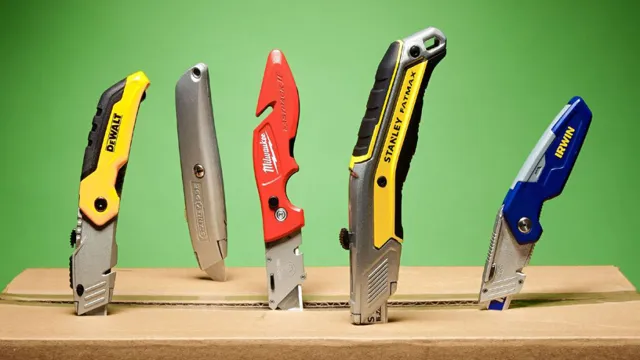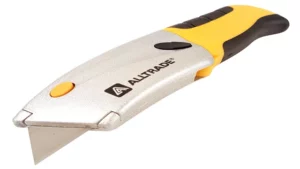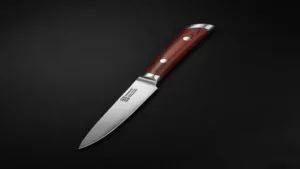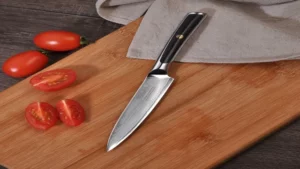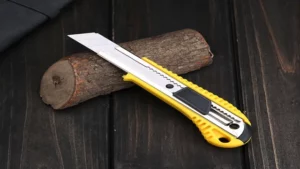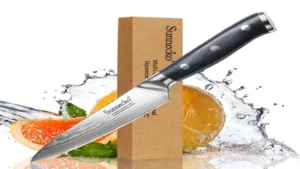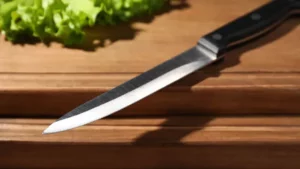Utility knives are versatile tools that have been used for centuries for various purposes. From outdoor activities such as camping and fishing to home improvement and DIY projects, a utility knife is an essential tool that you can use to complete various tasks. With so many options available in the market, choosing the right utility knife can be a daunting task.
But worry not, as we have put together a comprehensive guide to help you understand the use of utility knives and make an informed choice. In this guide, we will cover the various types of utility knives available in the market and their different uses. We will also discuss the factors to consider when choosing a utility knife, such as blade material, handle design, and blade locking mechanisms.
Additionally, we will provide tips on how to properly handle and maintain your utility knife to ensure its longevity. Whether you are a seasoned professional or a beginner, this guide will offer valuable insights into the world of utility knives. So, whether you are looking to replace an old utility knife or just starting out, read on to discover everything you need to know about the use of utility knives.
What is a Utility Knife?
A utility knife is a multi-purpose cutting tool designed to handle a range of tasks. These knives typically feature a sharp blade that is around 5-7 inches long and has a straight edge. The blade is made from a high-quality steel that maintains its sharpness even after extended use.
Utility knives are ideal for cutting a wide range of materials, including rope, cardboard, plastic, and even leather. They are also commonly used for food preparation, such as slicing vegetables or trimming meat. The main use of a utility knife is its versatility – it can be used for a wide range of applications and is an essential tool in any toolkit or kitchen.
Whether you need to cut through thick materials or make precise cuts, a utility knife is a must-have tool that offers excellent value for money.
Description of a Utility Knife
A utility knife is a handy tool that can be used for a variety of tasks. This versatile knife is designed to be used for various purposes, such as slicing, cutting, and trimming different materials, including wood, plastic, and paper. It usually has a sharp blade that is made of high-quality steel or titanium, making it durable and long-lasting.
The blade is often retractable, ensuring safety when not in use. Additionally, the utility knife usually has a comfortable handle, making it easy to grip and use while working. Whether you are a DIY enthusiast, a handyman, or a professional carpenter, a utility knife is a useful tool to have around.
It can be used for anything from opening packages to cutting intricate designs into thin layers of material. With its sharp, reliable blade and ergonomic handle, a utility knife is a must-have for anyone who needs a trustworthy cutting tool.
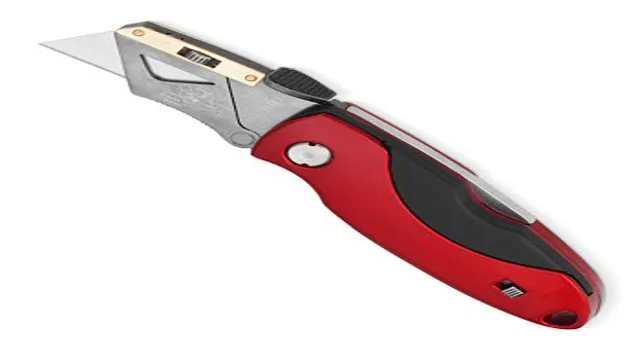
Types of Utility Knives
A utility knife is a versatile cutting tool that can be used for a wide range of tasks in both the kitchen and the workshop. These knives are typically smaller and more maneuverable than a traditional chef’s knife, making them ideal for jobs that require precision and control. There are several different types of utility knives, each designed to excel at specific tasks.
For example, a serrated utility knife has teeth along the blade, making it perfect for cutting through crusty bread or tough-skinned fruits and vegetables. A paring knife, on the other hand, has a shorter, straight blade that is ideal for peeling and trimming delicate produce. Other types of utility knives include the boning knife, which is specialized for removing bones from meat, and the fillet knife, which is designed for processing fish.
No matter what type of cutting task you need to tackle, there is likely a utility knife out there that is perfectly suited for the job.
Common Uses of Utility Knives
If you’re wondering what the use of a utility knife is, you may be surprised by just how versatile this tool can be. Utility knives are commonly used for cutting a wide range of materials, such as paper, cardboard, carpet, rope, and even food. They are a popular choice for DIY enthusiasts and professionals alike, and can be found in almost every tool kit.
Carpenters often use utility knives for precision cutting tasks, while chefs use them for slicing and dicing ingredients. In addition to these common uses, utility knives can be used for opening boxes, cutting insulation, removing sealants and caulking, and even for outdoor activities like hunting and camping. Overall, the utility knife is a practical and reliable tool that can be used for a variety of tasks, making it a valuable addition to any collection.
Cutting Boxes and Packages
Utility knives are handy tools that you can use for various tasks. One of the most common uses of these knives is cutting boxes and packages. Utility knives make it easy to unbox all sorts of items, from small electronics to large appliances.
They have sharp and durable blades that can cut through all types of cardboards, tapes, and plastics. With a utility knife, you can make clean and precise cuts without damaging the contents inside the boxes. Whether you’re moving into a new apartment, receiving a package from an online store, or shipping a gift to a friend, having a trusty utility knife can save you time and effort.
So, if you’re looking for a versatile cutting tool, a utility knife is definitely a must-have in your tool kit.
Craft and DIY Projects
Utility knives are a must-have tool for anyone who loves to work on DIY projects. They are versatile and can be used in a variety of ways, making them an essential tool for any DIY enthusiast. One of the most common uses of utility knives is for cutting and stripping wires.
They are also great for carving wood, trimming carpet, and cutting cardboard. Utility knives are the perfect tool for any job that requires precision cuts. They come in a variety of sizes and shapes, so it is important to choose the right one for the job.
When working with utility knives, it is important to always use a sharp blade and to be careful when cutting. With these tips in mind, you can confidently tackle any DIY project with a utility knife.
Food Preparation
Utility knives are an essential tool in any kitchen, and their versatility makes them perfect for a wide range of food preparation tasks. One of the most common uses of utility knives is for cutting fruits and vegetables. Their sharp, fine edges make them perfect for slicing through produce with ease, from large, tough vegetables like carrots and potatoes to softer, delicate fruits like berries and tomatoes.
They’re also great for slicing bread, from a loaf of crusty French bread to a softer white bread. Plus, utility knives are perfect for trimming meat, removing any unwanted fat or gristle to ensure you get the perfect cut every time. When it comes to food preparation, a high-quality utility knife is an essential tool in any kitchen.
Safety Tips for Using Utility Knives
What is the use of a utility knife? Utility knives are versatile cutting tools used for various tasks including crafts, construction, gardening, and even in the kitchen. While they are extremely useful, they can also be dangerous if not used properly. Here are some safety tips when using a utility knife: always keep the blade sharp, as a dull blade can cause slipping and accidents.
Use proper handling techniques such as gripping the knife firmly and avoiding shortcuts like cutting towards yourself. Always cut on a stable surface and be mindful of your body position. Finally, when not in use, store your utility knife in a safe place away from the reach of children.
With these tips in mind, you can safely and effectively use your utility knife for all your cutting needs.
Proper Grip and Hand Placement
When it comes to using utility knives, safety is of utmost importance. One of the key safety tips is to ensure a proper grip and hand placement on the knife. This means keeping your fingers away from the blade and always holding the handle firmly with your whole hand.
Avoid gripping the knife too tightly, as this can cause muscle strain and decrease your control over the blade. It’s also important to position your hand and fingers behind the blade, so that you can easily maneuver the knife without risking accidental cuts. With a little practice and attention to hand placement, you can use a utility knife safely and efficiently for all your cutting needs.
Sharpness and Maintenance
When it comes to using utility knives, safety should always come first. One of the most important safety tips to keep in mind is to maintain the sharpness of the blade. A dull blade can slip and cause serious injury, so it’s important to regularly sharpen your knife.
Additionally, make sure to use the proper technique when sharpening and honing your blade. Using a honing rod can help maintain the edge of the blade between sharpenings. Keeping your knife clean and dry, and storing it safely when not in use, will also help extend the life of the blade and ensure it remains sharp.
Remember, a sharp knife is a safe knife.
Conclusion: Why You Need a Utility Knife
In conclusion, a utility knife is the ultimate multi-purpose tool. It’s like having a superhero that can cut through cardboard, slice through rubber, and even chop up vegetables with ease. Whether you’re a chef, a DIY enthusiast, or just someone who appreciates a good slice in life, a utility knife is an essential addition to your arsenal.
So, let’s all raise a toast to the humble utility knife, the Swiss Army knife of blades!”
FAQs
What is a utility knife used for?
A utility knife is used for cutting and slicing a variety of materials, including cardboard, rope, leather, and even food.
What are the different types of blades for a utility knife?
The most common blades for a utility knife include the standard straight blade, serrated blade, hook blade, and concave blade.
How do you safely handle a utility knife?
To safely handle a utility knife, always keep it stored in a sheath or holster, use the appropriate blade for the task at hand, cut away from yourself, and never leave it unattended or accessible to children.
What is the difference between a utility knife and a pocket knife?
While both knives are versatile tools, a utility knife typically has a longer and thicker blade for heavier-duty tasks, while a pocket knife is smaller and more compact for everyday use.
Can a utility knife be sharpened?
Yes, a utility knife can be sharpened using a sharpening stone, honing rod, or electric sharpener, depending on the type of blade and personal preference.
What are some common industries that use utility knives?
Industries such as construction, manufacturing, landscaping, and food service often use utility knives for a variety of tasks, from cutting materials to preparing food.
Are there any safety features to look for when purchasing a utility knife?
Yes, some utility knives may have safety features such as a locking mechanism to keep the blade in place, slip-resistant handles for better grip, or retractable blades to prevent accidental cuts.
